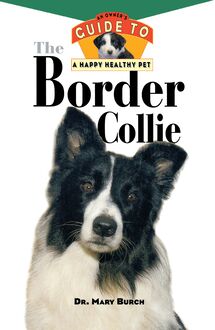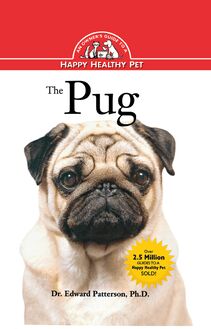First Aid For Dogs , livre ebook
84
pages
English
Ebooks
2007
Vous pourrez modifier la taille du texte de cet ouvrage
Obtenez un accès à la bibliothèque pour le consulter en ligne En savoir plus
Découvre YouScribe en t'inscrivant gratuitement
Découvre YouScribe en t'inscrivant gratuitement
84
pages
English
Ebooks
2007
Vous pourrez modifier la taille du texte de cet ouvrage
Obtenez un accès à la bibliothèque pour le consulter en ligne En savoir plus
Publié par
Date de parution
31 août 2007
Nombre de lectures
0
EAN13
9780470253250
Langue
English
Poids de l'ouvrage
2 Mo
PART ONE: Fundamentals of First Aid.
1. What Is First Aid?
2. Basics of First Aid.
PART TWO: Addressing Emergencies.
3. External Wounds.
4. Internal Problems.
5. Exposure and Other Environmental Injuries.
6. Head and Brain Problems.
7. Bone Injuries.
PART THREE: Beyond the Basics.
8. Recommended Reading.
Publié par
Date de parution
31 août 2007
Nombre de lectures
0
EAN13
9780470253250
Langue
English
Poids de l'ouvrage
2 Mo
First Aid for Dogs
Howell Book House
Howell Book House
A Simon Schuster Macmillan Company
1633 Broadway
New York, NY 10019
Copyright 1998 by Howell Book House
All rights reserved. No part of this book may be reproduced or transmitted in any form or by any means, electronic or mechanical, including photocopying, recording, or by an information storage or retrieval system, without permission in writing from the Publisher.
MACMILLAN is a registered trademark of Macmillan, Inc.
Library of Congress Cataloging-in-Publication Data
Schwartz, Stefanie.
First aid for dogs/Stefanie Schwartz.
-An owner s guide to a happy healthy pet
p. cm.
ISBN 0-87605-565-X
1. Dogs-Wounds and injuries-Treatment. 2. Dogs-Diseases-Treatment. 3. Veterinary emergencies. 4. First aid for animals. I. Title. II. Series.
SF991.S324 1998 98-16858
636.7 08960252-dc21 CIP
Series Director: Amanda Pisani
Assistant Series Director: Jennifer Liberts
Book Design: Michele Laseau
Cover Design: Iris Jeromnimon
Illustration: Casey Price
Photography:
Front rover by Winter Churchill Photography
Front caver inset by Paulette Braun (Pets by Paulette)
Back caver by Daniel Wallace
Joan Balzarini: 16, 96, 99
Cheryl Primeau: 19, 38, 46, 67, 73, 86, 101
Bob Schwartz: 2-3, 5, 6, 12, 15, 20, 35, 37, 44-45, 48, 54, 60, 68, 71, 77, 84, 88, 94, 102, 107, 114, 124
Stefanie Schwartz: 89
Judith Strom: 87, 93,116
Toni Tucker: 63
Faith Uridel: 69
Daniel Wallace: 10, 11, 17, 26, 30, 31, 32, 43, 49, 51, 52, 58, 65, 66, 74, 75, 85, 90, 92, 100, 109, 118,119,121, 122
Jean Wentworth: 23
Winter Churchill Photography: i
Production Team: Stephanie Mohler, Clint Lahnen, Angel Perez, Dennis Sheehan, Terri Sheehan
Contents
part one
Fundamentals of First Aid
1 What Is First Aid?
2 Basics of First Aid
part two
Addressing Emergencies
3 External Wounds
4 Internal Problems
5 Exposure and Other Environmental Injuries
6 Head and Brain Problems
7 Bone Injuries
part three
Beyond the Basics
8 Recommended Reading
chapter 1
What Is First Aid?
First aid is the first response to aid a dog in an emergency situation. Depending on the specific injury or illness, the dog may need only simple intervention to become stabilized. At the other extreme, there may be little anyone can do at the scene and immediate transfer to the nearest veterinary facility may be the best first aid.
There are many types of emergencies and some are more immediately life-threatening than others. Compare, for example, the severity between a dog that has broken his tail with a dog that has been hit by a car. A tail is not a vital organ and although the injury may be quite painful, it is unlikely to be life-threatening. A dog that has been hit by a car can suffer injuries that may range from minimal (perhaps only a few scrapes) to severe (such as internal bleeding) if the dog is lucky enough to survive the impact at all.
The Goals of First Aid
The primary goal of first aid is to take immediate and appropriate action to preserve the life of the patient. First aid is most valuable in extreme emergency situations when failure to respond could result in the dog s death.
The second goal of first aid is to prevent further deterioration of the dog. As soon as a physical problem becomes apparent, appropriate intervention is required to keep things from getting worse until trained professionals have an opportunity to intervene.
In almost every case, first aid should not replace veterinary attention. When in doubt, take your dog to the veterinarian for treatment.
The third goal of first aid is to relieve pain and discomfort. Pain is not necessarily a reliable indication of the severity of an injury or illness. Causing some pain to an injured dog may be unavoidable during first aid, for example, when the dog is gently lifted into your car for transport to the clinic. Moreover, it might not be advisable to relieve pain completely in an injured animal as the dog will likely try to move around before healing is complete.
And finally, the fourth goal of first aid is to ensure the health of the dog with immediate veterinary attention. The purpose of this book is not to teach everything there is to know about veterinary emergency medicine and care. As a devoted and concerned dog owner, it is important that you understand the basics of the most commonly encountered veterinary emergencies. In many situations, you will be able to make a difference by responding appropriately to help your sick or injured pet. But unless you are a veterinarian, you should not make decisions regarding your pet s safety or survival without the benefit of first-hand veterinary attention. First aid should be directed at your dog s initial care in the actual emergency situation or as soon as a problem is discovered. In almost every case, first aid should not replace subsequent veterinary attention.
THE CONTENTS OF YOUR FIRST AID KIT 2 rolls of gauze: 1 that is 2 inches wide and 1 that is 3 or 4 inches wide 1 roll of white surgical tape, 1 inch wide 2 rolls of elastic wrap, 1 that is 2 inches wide and 1 that is 3 or 4 inches wide 1 roll of cotton batting (12 inches wide) an emergency ice pack a bottle of 1 percent hydrogen peroxide a box of latex examination gloves or alternative gloves an extra collar and leash a soft muzzle; alternatively, a smooth nylon rope (about 2 to 3 feet long) or an old pair of panty hose can be tied for use as a soft muzzle, if necessary a blanket or beach towel (for warmth) a bath towel (can be used as splint) a bottle of saline eyewash a bottle of artificial tears 2 rectal thermometers or digital thermometers a pair of bandage scissors a pair of tweezers a flashlight (with extra batteries) a bottle of antihistamine a box of baking soda
First Aid Kit
The following items are easily obtained from your local pharmacy. You should store them in a moistureproof container that is easily accessible in an emergency (but out of reach of children and pets). In addition, include a list of emergency telephone numbers on an index card. You may want to have this laminated or place it inside a plastic cover. You might also include a copy of this book for quick reference as necessary. Think about making a duplicate kit to keep with you in the car in case something happens when you are away from home. If you often travel with your dog, research the availability of emergency veterinary coverage at your destination. The better prepared you are, the less likely you are to panic in case of an emergency.
Practice Before an Emergency
Practicing before an emergency can be a vital investment: The more comfortable you are in using the contents of the first aid kit, the more smoothly you can respond should the need arise. If your pet is cooperative, you could try making leg bandages or taking his temperature. (It is likely that your dog will be impatient with your unfamiliar manipulations, however; you could practice bandaging on a stuffed animal.) Practice lifting and carrying your dog according to the suggestions you will read later on in this book. Practice driving the route to your nearest veterinary emergency facility. Establish a professional relationship with the clinic and keep emergency telephone numbers handy (for example, in your wallet, in your car and on your refrigerator). Review this book periodically to keep basic concepts fresh in your mind.
How to Approach a Frightened or Injured Dog
In a medical emergency, an injured dog that remains conscious will almost certainly be in a state of extreme fear. His anxiety will be further amplified by any pain or disability that he may be experiencing. The animal s natural response will be to try to escape the scene of an accident and to seek shelter in a location where he will feel less vulnerable. Pain and confusion may lead to panic. If he is able to do so, an injured or frightened pet may try to run away if someone approaches, even if that individual is trying to help and even if it is you.
The powerful natural instinct to flee or to stand and fight can be even more pronounced in an injured or sick pet. An injured and panicking dog can easily get lost or worsen his injuries in an attempt to escape from what he perceives to be a menacing person. If the animal feels unable to escape the advance of a potentially harmful person, he may become aggressive, and thus injured or ill animals can be extremely dangerous. These pets must be approached slowly and with great care so as not to aggravate their state of anxiety or to trigger an attack. To approach a dog in an emergency situation (regardless of whether he is obviously afraid): Move toward the animal at a steady and very slow pace. Even if the injured or sick dog is your own, avoid the urge to rush to his aid because you could make the situation a lot worse for everyone. Keep your arms at your side and avoid sudden movements that could amplify a vulnerable dog s feeling of panic. Avoid direct eye contact with the dog. An animal that is in poor physical condition and unable to defend himself may perceive this as an aggressive challenge. Instead, avert your gaze to a point slightly past the animal s shoulder. Keep your voice soft and soothing. With your calming tone and reassuring words, you may avoid alarming the animal further and he might welcome your approach. Remember that our pets learn to become expert judges of our moods by our body language and verbal intonations. If you project an image of anxiety and panic, the vulnerable animal will become even more defensive.
MAKE AND KEEP REGULAR VETERINARY APPOINTMENTS
An effective way to prevent a health crisis is to make regular veterinary appointments for your dog. Your veterinarian may discover changes in your dog s health status that you have overlooked. He or she will also keep your dog s vaccinations up-to-date-a critical factor in keeping your dog well. If the animal seems to panic increasingly as you come closer, c














